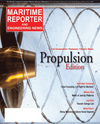
Page 47: of Maritime Reporter Magazine (September 2011)
Marine Propulsion Annual
Read this page in Pdf, Flash or Html5 edition of September 2011 Maritime Reporter Magazine
dock, then the dock is filled with water and the platform is floated to a nearbystaging area where the system is jacked up and fully tested with convenient near- shore access. If the system is completedon a dock, the finished assembly will be moved on rails onto a launch barge and the barge will be submerged. Once check out testing and certification is complete, the hull is lowered back into the water, the legs are raised, and the Titan is towed to the site. A tug boat is the only vessel required for deployment and installation.Jack up platforms operate in threemodes transit from one location to an- other, jacking up or down, and elevated on its legs. Each mode has specific pre- cautions and regulatory requirements to be followed to ensure smooth and safe operations.The transit mode occurs when the plat-form and turbine are being moved from one location (the dock) to another (thesite). The physics involved in moving jack up platforms under heavy loads is well understood, the turbine blades arepositioned as bunny ears with one blade secured to the tower and the other two blades tethered to the platform. Though the legs of the platform must be raised to ensure clearance of the seabedduring tow, the legs will be lowered as the water depth permits to lower the vertical center of gravity and reduce leg inertia loads due to tow motions. As the platform arrives at its permanent location, preparations are made to begin the jacking up mode. Jacking occurs in stages where the soil density below the feet (spud cans) is closely monitoredusing parametric acoustic (echo sound-ing) transducers installed inside the bot-tom of each leg. Soil information and predicted penetration curves beneath the spud cans are calculated and understoodbefore installation begins and is updated throughout the jacking operation.When the Titan is precisely positioned, the legs are lowered to the sea floor where the spud cans penetrate the toplayer of soil and begin to bear the load of the platform. The spud cans are designed to optimie soil penetration and allow the unit to be installed on uneven or sloping bottoms.As increasing load is brought to bear onthe soil, the legs continue to penetrate until the soil reaches maximum bearingpressure and the hull begins to lift. The legs and several ballast tanks inside the hull are then filled with sea water to in- crease the weight of the platform well be-yond the maximum loads of theoperational system.As the weight of the platform continuesto increase with added ballast and thelegs continue penetrating deeper into the soil, the hull is never allowed to raise more than a couple of feet above the nat- ural buoyant state of the hull. If a leg en- counters a punch through, where the leg suddenly penetrates a layer of soft soil or an underground cavity, the risk to the platform and turbine are minimied as the hull?s own buoyancy will compen- sate and absorb the sudden shift. If a leg encounters an obstacle, such as a boulder, the legs can be retracted, the platform can be rotated or moved, and the process can begin again. Once the soil?s maximum bearing pres- sure is again reached under the additionalweight of the platform with its full bal-last, the legs reach their maximum pene- tration depth and the system is consideredto be anchored sufficiently to overcome all maximum operational loads. At this point all the ballast water is discharged. The platform can then be jacked up to its operational height above the water, leav- ing an air gap underneath the platform ofabout 60 feet. The platform is lifted higher than the highest recorded stormwave for the location. Throughout the jacking process, each leg is controlled separately to ensure that the hull remainslevel at all times during the lift. September 2011www.marinelink.com 47The platform is towed to the installation site with the wind turbine already com- pletely installed. Upon arrival, its legs are lowered and embedded into the seabed and its hull is elevated to provide a stable foundation capable of with- standing extraordinary environmental loads.

 46
46

 48
48
